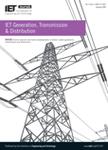版权所有:内蒙古大学图书馆 技术提供:维普资讯• 智图
内蒙古自治区呼和浩特市赛罕区大学西街235号 邮编: 010021

作者机构:Aeronaut Univ Sci & Technol Dept Elect Engn Tehran Iran Amirkabir Univ Technol Dept Elect Engn Tehran Iran
出 版 物:《IET GENERATION TRANSMISSION & DISTRIBUTION》 (IET Gener. Transm. Distrib.)
年 卷 期:2016年第10卷第9期
页 面:2058-2065页
核心收录:
主 题:power distribution control reactors (electric) fault current limiters power distribution faults overvoltage potential transformers ferroresonance ferroresonant circuits power engineering computing control engineering computing dual function ferroresonance fault current limiter DC reactor DC reactor-based ferroresonance ferroresonance oscillation stabilisation potential transformer distribution network ferroresonance overvoltage DRFFCL short-circuit faults occurrence MATLAB software scaled-down laboratory prototype voltage 33 kV
摘 要:This study presents a novel DC reactor-based ferroresonance and fault current limiter (DRFFCL) for stabilising ferroresonance oscillations of potential transformer (PT) in 33 kV distribution network and decreasing the amplitude of the fault current to an acceptable level. At first, the ferroresonance overvoltage is introduced and various types of overvoltage in the PT are studied. Then, the effects of the suggested DRFFCL on these oscillations are investigated. It is shown that the proposed DRFFCL not only can control the ferroresonance oscillations, but also can decrease the fault current amplitude in the case of short-circuit faults occurrence. The DRFFCL performance is simulated using MATLAB software and a scaled-down laboratory prototype is implemented and tested for the simulation results validation. The measured results are in agreement with the simulation results and clearly show the ability of the DRFFCL for controlling both the ferroresonance overvoltage and fault current.